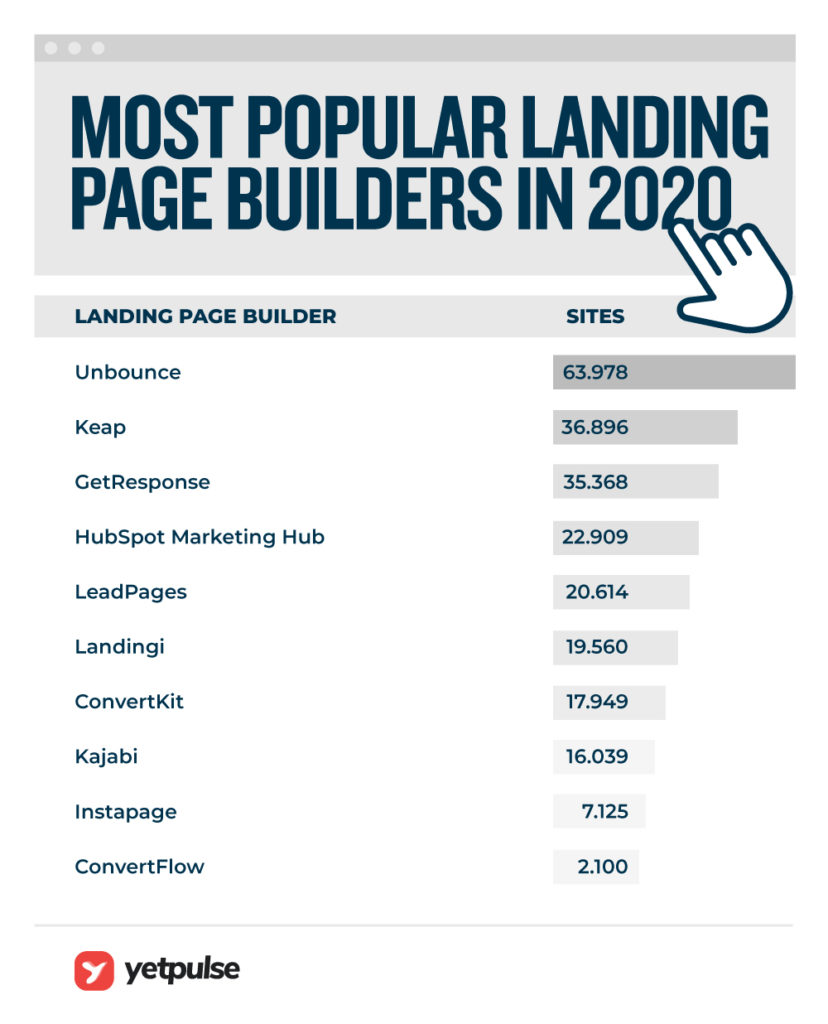Best Landing Page Builders in 2022
With so many landing page builders on the market, it can be hard to understand which one will deliver the results you need. No matter what business you’re running, your landing page needs to look sharp, professional, and have a solid call to action to draw your customers in.
So how can you decipher which landing page builder software will be the most effective for your business?
Top Landing Page Builders
- Landingi
- LeadPages
- ConvertFlow
- Unbounce
- ConvertKit
- Instapage
- GetResponse
- HubSpot Marketing Hub
- Keap
- Kajabi
| Starting Price / Month | Free Trial | Integrations | Built-in email marketing | AMP pages | Pop-ups | Personalization | |
|---|---|---|---|---|---|---|---|
 Landingi Landingi | $29 | 14 days | View integrations | No | No | Yes | Dynamic Text Replacement and Dynamic Traffic Routing |
 LeadPages LeadPages | $25 | 14 days | View integrations | No | No | Pop-ups + Sticky bars | No |
 ConvertFlow ConvertFlow | $29 | Free plan | View integrations | No | No | Pop-ups, Sticky bars and Side-in | Behavior history, CRM based personalization, Dynamic Text Replacement |
 Unbounce Unbounce | $72 | 14 days | View integrations | No | Yes | Pop-ups + Sticky bars | Dynamic Text Replacement and Dynamic Traffic Routing |
 ConvertKit ConvertKit | $25 | Free plan | View integrations | Yes | No | Pop-ups + Side in | No |
| $149 | 14 days | View integrations | No | Yes | Yes | 1:1 personalization for ads | |
 GetResponse GetResponse | $10.5 | 30 days | View integrations | Yes | No | Yes | No |
 HubSpot HubSpot | $40 | 14 days | View integrations | Yes | No | Yes | No |
 Keap Keap | $149 | 30 days | View integrations | Yes | No | No | No |
 Kajabi Kajabi | $119 | 14 days | Yes | No | Yes | No |
Most Popular Landing Page Builder

Define Your Goals
Before you even consider what you want your landing page to look like, you need to understand what you’re trying to get people to do. This will look different for every business, and many businesses often run multiple landing pages for different products and services.
Step one is to understand what you want customers to do. Do you want them to sign up for your email list? If so, you probably don’t need an extensive, flashy landing page, like you might if you’re convincing them to take out a trial of your software or book a consulting call.
Where’s Your Landing Page?
Many companies run their landing pages differently. For smaller brands, their landing page is often their homepage, while larger companies may make multiple landing pages within their website. Others may choose to purchase a separate domain to act as their landing page.
Again, where you host your landing page will depend on what you’re trying to do. Google, for instance, has product landing pages on its store website to show off individual products and their features, with a CTA to purchase the product.
In comparison, Simba’s homepage serves as the landing page. On this page, customers immediately see the most important feature they’re looking for in a mattress, as well as a CTA to look at their sale promotion.
Templates vs. Custom Build
Templates can be a great option, particularly if you aren’t code-savvy and want to get your landing page up and running as soon as possible. However, templates don’t always work for every business. I like to have the option to add custom code to templates so I can make them unique, but unfortunately, this isn’t a feature all landing page builders have.
The vast majority of landing page building software available works either solely on templates, or has some option to make changes to the page’s CSS. However, most of these sites also have thousands of templates to choose from, so you won’t be left feeling like you’re copying someone else’s website.
If you want to completely custom build your landing page, I wouldn’t recommend using a landing page builder, as the options to change the codebase is very limited.
How Much Can You Afford?
With the growth of Software as a Service (SaaS), there are more landing page builders available than ever before. These can range anywhere from free to hundreds of dollars a month.
If you haven’t got any budget to spend, the free landing page builders will be sufficient for your needs. They don’t always have all the bells and whistles, but they get the job done. However, if you’ve got a bigger marketing budget, the paid-for builders offer you more versatility.



